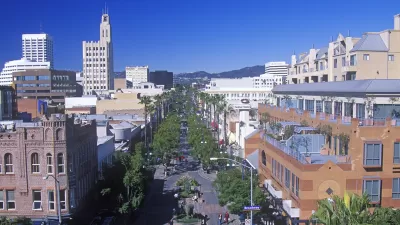Mayor Ted Winterer and Mayor Pro Tem Gleam Davis elaborate on the city’s new Downtown Community Plan, which includes what may be the state's highest inclusionary housing requirement.

After six years of planning beset by controversy, Santa Monica recently approved a new vision for its Downtown. Mayor Ted Winterer and Mayor pro Tem Gleam Davis spoke frankly to The Planning Report about the intentions, and the politics, behind the new plan.
While proponents say the plan represents a more balanced approach to growth and preservation since the city's solid rejection of dramatic development restrictions in November, critics say it doesn't do enough to accommodate the city's rapid population growth.
Either way, the plan makes a number of bold moves, including eliminating minimum parking requirements in the downtown area—devoting attention instead to Vision Zero goals and building on the success of the Expo Line through bike paths, bus-only lanes, and a valet system at the edge of Downtown. But perhaps most significantly, the new plan imposes a 30 percent affordable housing requirement on major residential projects.
"Santa Monica has long been viewed as being on the cutting edge of urban planning as well as social and environmental policy innovation," Davis notes. Recently, the city imposed substantial water restrictions on major developments, and required new single-family homes to meet net-zero energy standards.
In TPR, Davis—who voted against the inclusionary housing proposal—worries that the new policy "missed the mark." But Winterer says that in desperate times, going big is worth a shot.
"Is there a risk we've aimed too high?” he asks rhetorically. “Sure—but given the rapid erosion of socioeconomic diversity in our city, and the dire need for affordable housing, it's a risk I'm prepared to take."
Plus, he suggests the risks may not be as high as some fear:
Every time we’ve levied new costs and demands on future development, whether through a Transportation Impact Fee or water-use neutrality requirements, we've been told that new projects won’t be able to absorb those burdens. Yet the applications keep rolling across the transom at City Hall...
While it may take some time for land values to adjust accordingly, I believe high demand for housing and a limited opportunity to build will yield projects which meet the more ambitious standards.
FULL STORY: The 'Art of the Possible': Santa Monica's New Downtown Community Plan

Trump Administration Could Effectively End Housing Voucher Program
Federal officials are eyeing major cuts to the Section 8 program that helps millions of low-income households pay rent.

Planetizen Federal Action Tracker
A weekly monitor of how Trump’s orders and actions are impacting planners and planning in America.

Ken Jennings Launches Transit Web Series
The Jeopardy champ wants you to ride public transit.

California Invests Additional $5M in Electric School Buses
The state wants to electrify all of its school bus fleets by 2035.

Austin Launches $2M Homelessness Prevention Fund
A new grant program from the city’s Homeless Strategy Office will fund rental assistance and supportive services.

Alabama School Forestry Initiative Brings Trees to Schoolyards
Trees can improve physical and mental health for students and commnity members.
Urban Design for Planners 1: Software Tools
This six-course series explores essential urban design concepts using open source software and equips planners with the tools they need to participate fully in the urban design process.
Planning for Universal Design
Learn the tools for implementing Universal Design in planning regulations.
Ada County Highway District
Clanton & Associates, Inc.
Jessamine County Fiscal Court
Institute for Housing and Urban Development Studies (IHS)
City of Grandview
Harvard GSD Executive Education
Toledo-Lucas County Plan Commissions
Salt Lake City
NYU Wagner Graduate School of Public Service





























